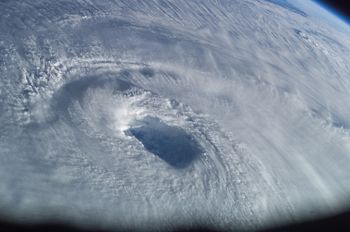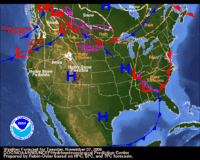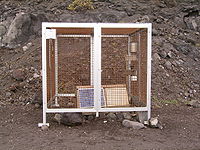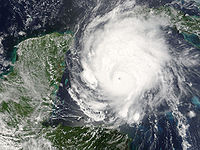- Outline of meteorology
-
See also: Index of meteorology articles
Meteorology is the interdisciplinary scientific study of the atmosphere that focuses on weather processes and forecasting. Meteorological phenomena are observable weather events which illuminate and are explained by the science of meteorology. Those events are bound by the variables that exist in Earth's atmosphere. They are temperature, pressure, water vapor, and the gradients and interactions of each variable, and how they change in time. The majority of Earth's observed weather is located in the troposphere.[1][2]
The following outline is provided as an overview of and topical guide to meteorology:
Contents
Essence of meteorology
- Main article: Meteorology
- Climate – the average and variations of weather in a region over long periods of time.
- Meteorology – the interdisciplinary scientific study of the atmosphere that focuses on weather processes and forecasting (in contrast with climatology).
- Weather – the set of all the phenomena in a given atmosphere at a given time.
Branches of meteorology
- Microscale meteorology – the study of atmospheric phenomena about 1 km or less, smaller than mesoscale, including small and generally fleeting cloud "puffs" and other small cloud features
- Mesoscale meteorology – the study of weather systems about 5 kilometers to several hundred kilometers, smaller than synoptic scale systems but larger than microscale and storm-scale cumulus systems, such as sea breezes, squall lines, and mesoscale convective complexes
- Synoptic scale meteorology – is a horizontal length scale of the order of 1000 kilometres (about 620 miles) or more
Methods in meteorology
- Surface weather analysis – a special type of weather map that provides a view of weather elements over a geographical area at a specified time based on information from ground-based weather stations
Weather forecasting
Weather forecasting – the application of science and technology to predict the state of the atmosphere for a future time and a given location
Data collection
- Pilot Reports
Weather maps
Forecasts and reporting of
- Atmospheric pressure
- Dew point
- High pressure area
- Ice
- Low pressure area
- Precipitation
- Temperature
- Weather front
- Wind chill
- Wind direction
- Wind speed
Instruments and equipment of meteorology
- Anemometer – a device for measuring wind speed; used in weather stations
- Barograph – an aneroid barometer that records the barometric pressure over time and produces a paper or foil chart called a barogram
- Barometer – an instrument used to measure atmospheric pressure using either water, air, or mercury; useful for forecasting short term changes in the weather
- Ceiling balloon – a balloon, with a known ascent rate, used to measure the height of the base of clouds during daylight
- Ceiling projector – a device that is used, in conjunction with an alidade, to measure the height of the base of clouds
- Ceilometer – a device that uses a laser or other light source to measure the height of the base of clouds.
- Dark adaptor goggles – clear, red-tinted plastic goggles used either for adapting the eyes to dark prior to night observation or to help identify clouds during bright sunshine or glare from snow
- Disdrometer – an instrument used to measure the drop size, distribution, and velocity of falling hydrometeors
- Field mill – an instrument used to measure the strength of electric fields in the atmosphere near thunderstorm clouds
- Hygrometer – an instrument used to measure humidity
- Ice Accretion Indicator – an L-shaped piece of aluminum 15 inches (38 cm) long by 2 inches (5 cm) wide used to indicate the formation of ice, frost, or the presence of freezing rain or freezing drizzle
- LIDAR (LIght Detection And Ranging) – an optical remote sensing technology used in atmospheric physics (among other fields) that measures the properties of scattered light to find information about a distant target
- Lightning detector – a device, either ground-based, mobile, or space-based, that detects lightning produced by thunderstorms
- Nephelometer – an instrument used to measure suspended particulates in a liquid or gas colloid. Gas-phase nephelometers are used to provide information on atmospheric visibility and albedo
- Nephoscope – an instrument for measuring the altitude, direction, and velocity of clouds
- Pyranometer – A type of actinometer found in many meteorological stations used to measure broadband solar irradiance
- Radar – see Weather radar
- Radiosonde – an instrument used in weather balloons that measures various atmospheric parameters and transmits them to a fixed receiver
- Rain gauge – an instrument that gathers and measures the amount of liquid precipitation over a set period of time
- Snow gauge – an instrument that gathers and measures the amount of solid precipitation over a set period of time
- SODAR (SOnic Detection And Ranging) – an instrument that measures the scattering of sound waves by atmospheric turbulence
- Solarimeter – a pyranometer, an instrument used to measure combined direct and diffuse solar radiation
- Sounding rocket – an instrument-carrying sub-orbital rocket designed to take measurements and perform scientific experiments
- Stevenson screen – part of a standard weather station, it shields instruments from precipitation and direct heat radiation while still allowing air to circulate freely
- Sunshine recorders – devices used to indicate the amount of sunshine at a given location
- Thermograph – a chart recorder that measures and records both temperature and humidity
- Thermometer – a device that measures temperature or temperature gradient
- Weather balloon – a high-altitude balloon that carries instruments aloft and uses a radiosonde to send back information on atmospheric pressure, temperature, and humidity
- Weather radar – a type of radar used to locate precipitation, calculate its motion, estimate its type (rain, snow, hail, etc.) and forecast its future position and intensity
- Weather vane – a movable device attached to an elevated object such as a roof that shows the direction of the wind
- Windsock – a conical textile tube designed to indicate wind direction and relative wind speed
- Wind profiler – equipment that uses radar or SODAR to detect wind speed and direction at various elevations
History of meteorology
- Main articles: History of meteorology and Timeline of meteorology
- History of weather forecasting – prior to the invention of meteorological instruments, weather analysis and prediction relied on pattern recognition, which was not always reliable
- History of surface weather analysis – initially used to study storm behavior, now used to explain current weather and as an aid in short term weather forecasting
Meteorological phenomena
- Atmospheric pressure – the pressure at any given point in the Earth's atmosphere
- Cloud – a visible mass of droplets or frozen crystals floating in the atmosphere above the surface of a planet
- Rain – precipitation in which separate drops of water fall to the Earth from clouds, a product of the condensation of atmospheric water vapor
- Snow – precipitation in the form of crystalline water ice, consisting of a multitude of snowflakes that fall from clouds
- Freezing rain – precipitation that falls from a cloud as snow, melts completely on its way down, then passes through a layer of below-freezing air becoming supercooled, at which point it will freeze upon impact with any object encountered
- Sleet – term used in the United States and Canada for precipitation consisting of small, translucent ice balls, usually smaller than hailstones
- Tropical cyclone – a storm system with a low pressure center and numerous thunderstorms that produce strong winds and flooding rain
- Extratropical cyclone – a low-pressure weather system occurring in the middle latitudes of the Earth having neither tropical nor polar characteristics
- Weather front – a boundary separating two masses of air of different densities; the principal cause of meteorological phenomena
- Low pressure – a region where the atmospheric pressure is lower in relation to the surrounding area
- Storm – any disturbed state of the atmosphere and strongly implying severe weather
- Flooding – an overflow of an expanse of water that submerges the land; a deluge
- Nor'easter – a macro-scale storm along the East Coast of the United States, named for the winds that come from the northeast
- Wind – the flow of air or other gases that compose an atmosphere; caused by rising heated air and cooler air rushing in to occupy the vacated space.
- Temperature – a physical property that describes our common notions of hot and cold
- Invest (meteorology) – An area with the potential for tropical cyclone development
Atmospheric conditions
- Absolute stable air
- Adiabatic heating
- Anticyclone
- Dine's compensation
- Extratropical cyclone
- Orographic lift
- Precipitation
- Temperature inversion
- Thermal
- Vertical draft
Air pollution
- Arctic haze
- Asian brown cloud
- Air pollution dispersion modeling
- Black carbon
- Contrail
- Global dimming
- List of atmospheric dispersion models
- Smog
Climatic or Atmospheric Patterns
- Alberta clipper
- Antarctic oscillation
- Arctic dipole
- Arctic oscillation
- Atlantic multidecadal oscillation
- Atmospheric river
- Block
- Cold wave
- Chinook
- El Niño
- Derecho
- Gulf Stream
- Heat wave
- Indian Ocean Dipole
- Intertropical Convergence Zone
- Jet stream
- Katabatic wind
- La Niña
- Lake effect
- Madden-Julian oscillation
- Nor'easter
- North Atlantic Drift
- North Atlantic Oscillation
- Outflow boundary
- Pacific decadal oscillation
- Pacific-North American teleconnection pattern
- Pineapple Express
- Rossby wave
- Santa Ana winds
- Siberian Express
- Sirocco
- Tropical upper tropospheric trough
- Undular bore
- Walker circulation
- Weather bomb
- Western Hemisphere Warm Pool
Storms
Elements of storms
Types of storm
- Blizzard – a severe winter storm condition characterized by low temperatures, strong winds, and heavy blowing snow
- Cyclone
- Hybrid low (both tropical and non-tropical characteristics)
- Tropical cyclone (hurricane or typhoon)
- Eye (cyclone)
- Dust storm
- Macroburst
- Mesocyclone
- Microburst
- Supercell
- Thunderstorm – a storm characterized by the presence of lightning and its attendant thunder
- Tornado
Specific storms, by region
- List of Category 5 Atlantic hurricanes
- List of Category 5 Pacific hurricanes
- List of retired Pacific hurricane names
- List of retired Atlantic hurricane names
- List of Connecticut tornadoes
- List of Florida hurricanes
- List of North Carolina hurricanes
- List of California hurricanes
- List of Arizona hurricanes
- List of New Jersey hurricanes
- List of New York hurricanes
- List of New England hurricanes
- List of Texas hurricanes
- List of Atlantic hurricanes
- List of Pacific hurricanes
- List of Russian meteorologists
- List of snow events in Florida
- Weather disasters
- Extreme weather
- List of floods
- List of natural disasters by death toll
- List of severe weather phenomena
Leaders in meteorology
- William M. Gray (born 1929) – has been involved in forecasting hurricanes since 1984
- Francis Galton (February 16, 1822 - January 17, 1911) – was a polymath, and devised the first weather map, proposed a theory of anticyclones, and was the first to establish a complete record of short-term climatic phenomena on a European scale
- Herbert Saffir (March 29, 1917 – November 21, 2007) – was the developer of the Saffir-Simpson Hurricane Scale for measuring the intensity of hurricanes
- Bob Simpson (born 1912) – is a meteorologist, hurricane specialist, first director of the National Hurricane Research Project, former director of the National Hurricane Center, and co-developer of the Saffir-Simpson Hurricane Scale
Meteorology lists
- Main article: List of meteorology topics
See also
- Index of meteorology articles
- Meteorology
- Standard day
- Jet stream
- Heat index
- Equivalent potential temperature (Theta-e)
- Primitive equations
Other phenomena:
- Deposition
- Dust devil
- Fog
- Tide
- Wind
- Cloud
- Air mass
- Evaporation
- sublimation
- Crepuscular rays
- Anticrepuscular rays
References
External links
Outlines General reference · Culture and the arts · Geography and places · Health and fitness · History and events · Mathematics and logic · Natural and physical sciences · People and self · Philosophy and thinking · Religion and belief systems · Society and social sciences · Technology and applied sciencesCategories:- Outlines
- Meteorology
- Meteorology lists
Wikimedia Foundation. 2010.




